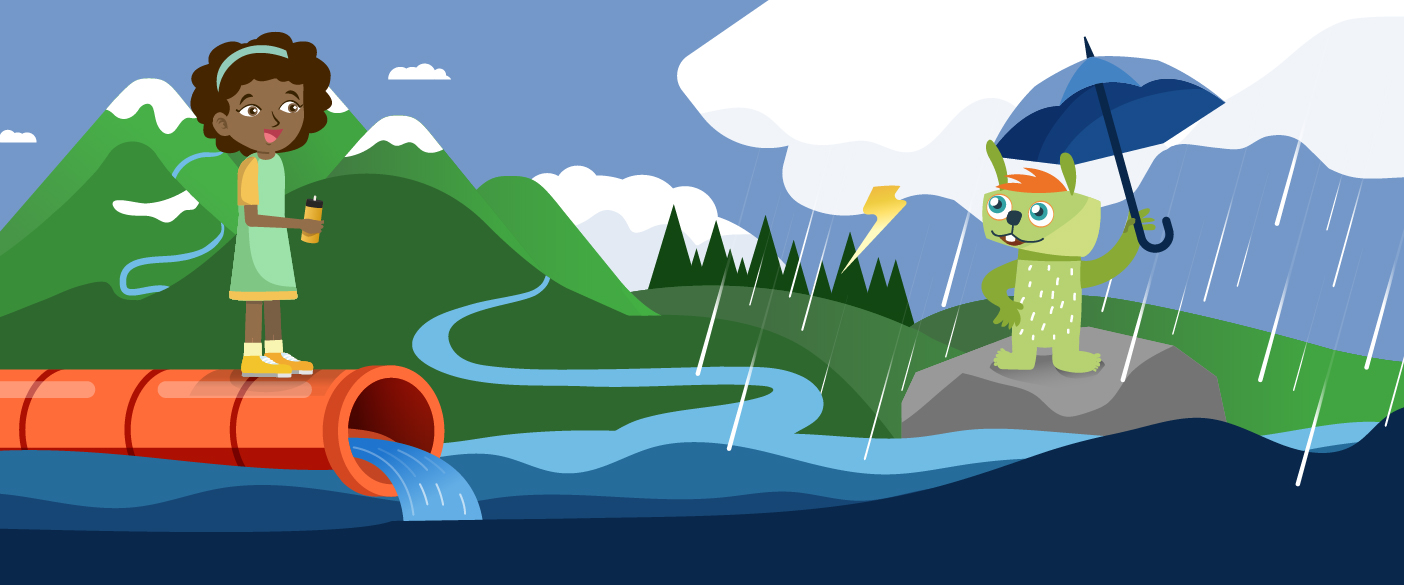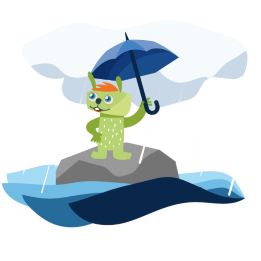What Happens to Polluted Water within the Water Cycle?

Overview
Overview
Keywords: float, sink, water, sea, lake, river, canal, pollution, marine life, biodiversity
Subjects: science, geography, citizenship, environmental education
Age group: 6-10 years old
Difficulty level: ● ○ ○ (easy)
![]()
![]()
![]()
![]()
This experiment is part of the unit "Water Works" written by: Iro Koliakou (GR), Cláudia Meirinhos (PT), Jane Shimizu (IE)
Water is a fundamental resource, and understanding its natural purification processes is crucial for students' environmental awareness. This activity aims to provide students with a hands-on experiment that elucidates the remarkable concept of the water cycle as a natural purification system.
This experiment takes inspiration from the Earth's water cycle, a process that continually recycles and purifies water, making it suitable for consumption.
The experiment
Required materials
- a large, open, transparent container (e.g. a 5 L plastic bottle cut open, a large plastic food container, or a glass tub)
- red paint and a brush or food colouring (to dye the water)
- a cup or glass (to collect the "rain")
- plastic film or plastic wrap (to cover the top of the bottle)
- scissors
- a small, heavy stone or a weight (to apply pressure and simulate rain)
- water
- sunlight (to place the setup near a sunny window for evaporation)
- a pot with a plant to simulate the soil and a tree (optional)
Experiment guide
- Begin by recalling the concept of the water cycle and explaining that the experiment will simulate this natural process.
- Choose the container. In the video, a 5 L bottle was used.
- Cut the top, if you chose a 5 L bottle.
- Put the pot with a plant inside the container.
- Fill the container with water.
- Add a few drops of red paint with the brush or food colouring to the water to dye it. This represents the initial impurities.
- Place the cup or glass inside the bottle. Make sure it is dry inside and show it to the students.
- Cover the top of the container with plastic film, making sure it's sealed tightly.
- Place the small, heavy stone on top of the plastic film, above the cup.
- Put the setup near a sunny window where it can receive direct sunlight.
- Wait for at least two hours and see what is inside the cup or glass.
Questions for students
Here are suggestions for questions that you could ask the students when the video stops.
- What do you think will happen to the water in the bottle when we place it near the window in the sunlight?
- What role do you think the plastic film and stone play in this experiment?
- Can you explain the concept of evaporation in your own words?
- What do you expect to see on the plastic film after some time has passed, and why?
- How does the weight of the stone help water droplets to collect and fall?
- And what does this have to do with the formation of precipitation in the atmosphere?
- Why is the process we're demonstrating important for the environment and our daily lives?
- How might the water collected in the cup differ from the water in the bottle, and why?
The experiment with the result
The water cycle, a fundamental aspect of Earth's natural processes, involves the continuous movement of water from the Earth's surface to the atmosphere and back again. The key stages in the water cycle are evaporation, condensation, and precipitation. Here's how these stages relate to the experiment:
Evaporation
In the experiment, the initial water in the bottle is dyed with red paint or food colouring to represent impurities. When you place the setup near a sunny window, the sun's energy causes the water to heat up. As a result, water molecules at the surface gain enough energy to change from a liquid state to a gas (water vapour). This process is called evaporation. It's like the water "disappearing" into the air.
Condensation
The water vapour rises within the bottle and reaches the plastic film covering the top. This plastic film simulates the upper atmosphere where temperatures are cooler. When the warm water vapour comes into contact with the cooler surface of the plastic film, it loses energy and transforms back into tiny water droplets. This process is called condensation. These water droplets accumulate on the plastic film, simulating the formation of clouds in the real atmosphere.
Precipitation
As more and more water vapour condenses into water droplets, they accumulate on the plastic film. The stone placed on top of the bottle causes the plastic film to bend and the condensed water slides over it to the lowest point. When enough water droplets have formed and their combined weight overcomes the resistance of the plastic film, they "fall" or "rain" into the cup below. This is precipitation, and it mimics the process of rain or other forms of water falling from the sky in the natural water cycle.
The experiment
The experiment illustrates how water is naturally purified in the water cycle. Water at the surface evaporates and leaves impurities behind. This process ensures that the water we receive in the form of precipitation is relatively clean and safe for use. A similar process takes place when salt is formed: water vapour rises into the atmosphere, leaving salt crystals behind.
In the explanatory video, the drops of water appear to have a definite shape. This typical drop-like shape is a common misconception. We are aware that the drops do not in reality have this shape but are round, but we use this image as it is common for kids.
How does this video link to sustainability?
The experiment directly demonstrates the natural water cycle's role as a purification system. It shows how impure water, represented by the dyed water in the bottle, is transformed into clean and clear rainwater. This showcases the Earth's natural system to sustain its water resources.
The project instils an understanding of the environment's delicate balance and the importance of preserving clean water sources. It highlights how nature efficiently recycles and purifies water, emphasising the need for responsible water use to maintain sustainability.
The practical experiment shown in the video helps inspire the next generation of environmental stewards. It demonstrates that through STEM education and scientific understanding, individuals can contribute to sustainable practices and protect the planet.
Differentiated learning
Explore ideas how you can use this material in your class and adapt it to a group of various levels and learning styles.
Easier
To simplify, you may include more visual aids, drawings, and pictures to help the students grasp the idea of the experiments. Use step-by-step visual instructions alongside written or spoken instructions.
For students with special needs, you may need to modify the materials so they are more accessible, such as using larger containers or tactile elements for students with visual impairments.
More challenging
With advanced or gifted students, encourage them to explore the scientific concepts in more depth. They could research the water cycle's impact on the environment. You can introduce additional variables or complexities, such as the use different colours for dye, and compare the results. Allow advanced students to design their own experiments related to the water cycle.
If you have multi-grade or multilevel classes, you can make groups with students of different ages and levels and encourage them to mentor and assist their peers. Use flexible grouping, allowing students to work with peers of different ages and abilities to foster collaboration.
Career orientation
Which career options are linked to this experiment and how can you introduce them to your students?
Working for healthy water bodies
Hydrologist
Hydrologists specialize in the study of water resources. They analyse the distribution, movement, and quality of water in the Earth's atmosphere and on its surface, which is directly relevant to the water cycle concept in this experiment.
Water quality analyst
Water quality analysts assess and monitor the quality of water in various settings, such as rivers, lakes, and water treatment facilities. They ensure that water sources are safe and clean for human use.
Water resource manager
Water resource managers are responsible for overseeing the sustainable use and conservation of water resources at a waterworks. They work to ensure the efficient use of water for agriculture, industry, and municipal purposes.
Working for the environment
Climate scientist
Climate scientists study long-term patterns in weather and climate, and they investigate how climate change impacts the Earth's hydrological cycle, making this experiment relevant to their field.
Environmental engineer
Environmental engineers design solutions to environmental problems, such as water treatment systems and pollution control technologies. They play a crucial role in ensuring water quality and sustainability.
Environmental scientist
Environmental scientists study the natural world and its ecosystems. They work to understand and solve environmental issues, such as water quality and sustainability. This experiment provides a foundation for those interested in environmental science careers.
Meteorologist
Meteorologists study atmospheric processes, including those related to precipitation and the formation of clouds. Understanding the principles of condensation and precipitation in the water cycle is foundational for a career in meteorology.
Outlook
As we conclude this experiment, it's crucial to emphasise that the knowledge gained here extends beyond the classroom. The water cycle, as a natural filtration system, illustrates the Earth's inherent ability to maintain clean water resources. This understanding empowers students to become responsible stewards of the environment and advocates for sustainable water use.
If possible, teachers may consider arranging a field trip to a local water treatment facility or a natural water source to observe the water cycle in action and learn about real-world water filtration methods.
Teachers may also consider conducting a separate experiment that demonstrates water filtration methods, helping students understand how we can artificially clean and purify water for consumption.
Water cycle, Encyclopædia Britannica
(last accessed 05.02.2025)Collection: The Water Cycle, National Geographic
(last accessed 05.02.2025)In How Water Works (taken from Coding in STEM Education), students can learn about rainwater using a Calliope microcontroller and LEGO bricks.
Career orientation links:
Hydrologist, Career Girls
Environmental scientists, Career Girls
Meteorologist, Career Girls(last accessed 01.04.2025)
This experiment is part of the unit "Water Works" written by: Iro Koliakou (GR), Cláudia Meirinhos (PT), Jane Shimizu (IE)
Share this page

